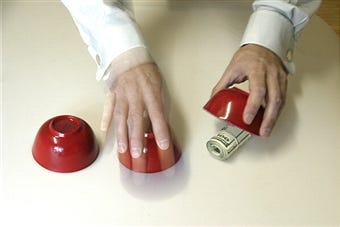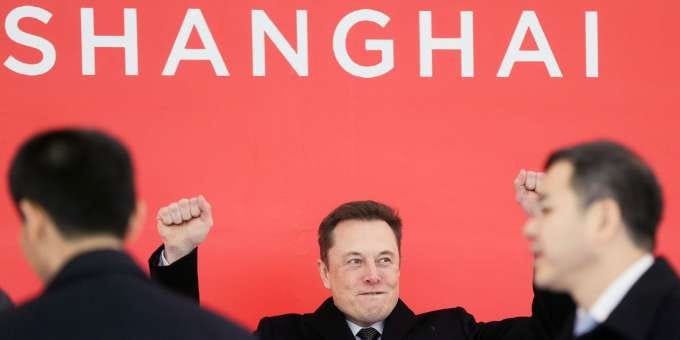Tesla's Q3 "Magic" Fades Quickly in Q4
Total deliveries fell 10% y/y in October; lowest since tepid February • M3 deliveries down 65% vs September, -27% y/y • Cue shiny object: Cyberpunk truck reveal November 21
Ford Motor Co (F US) revealed on Sunday night its sexy new Mustang Mach-E, which is aimed squarely at Tesla's Model Y and set to hit the market about the same time next year.
Tesla Motors (TSLA US) hardly needs even more demand pressure. Estimates out Friday from Ev-Sales.blogspot showed Tesla's global deliveries fell 10% y/y in October to the lowest levels since tepid February results despite sales being fully ramped-up now in all major markets.
Model 3 deliveries led the decline by falling 65% versus September, down 27% y/y, which threatens Tesla's ambitious, albeit dramatically reduced guidance for fourth-quarter deliveries.
Investors may not notice or care since they’re still celebrating Tesla's surprise third-quarter profit by driving the stock up 41% to $359.50, the highest since December last year, and its bonds up four points to 96.2 (6.1% ytw), the highest since December 2017.
Never mind that net income fell 54% versus last year on revenue down 8%, gross profit down 22%, and EBITDA down 7%. Free cash flow plunged 58%.
Or that all of Tesla's "profit" in the third quarter was traced entirely to nonrecurring & nonoperating items and evolving accounting maneuvers which continue to mask ongoing weakness in operations, much like the similarly constructed contributions I identified in third-quarter results last year (see my report Great Magic Trick Tesla; Now Do It Again, 11/29/18) and in every quarter since then.
Such boosts comprised more than $1.1 billion (54%) of reported LTM EBITDA as of September 30th, with leverage "improved" as a result to a still high 6.3x versus the unvarnished 11.6x multiple on core operating EBITDA (see attached model).
That's the problem with magic—it's not real, or sustainable.
The cliff-notes version of the third quarter was surprise profit on record deliveries versus breakout results last year which had marked the first full quarter of Model 3 sales and production.
Deliveries were up this year by 16% to 97,186, but only because incremental sales of Model 3 into new markets in Europe and China offset sharply lower Model 3 sales in the US (down 14%) and a 37% drop for Models S+X deliveries overall, confirming my concerns raised in Tesla Q2 Deliveries Beat; Demand and Profit Trends Less Clear (7/7/19) and subsequent reports about escalating weakness in demand that drastic pricing discounts can't seem to fix.
Deliveries also trailed the 101,000-121,000 Tesla needed to get back on pace to meet its guidance of 360,000-400,000 for the year, as I expected.
Indeed, Tesla quietly dropped the top end of that range this quarter--a decline by 40,000 deliveries versus expectations management had affirmed all year.
Even 360,000 deliveries for the year means 104,400 deliveries for the fourth quarter, which implies 84,400 deliveries in November and December. That's a tall order, and I suspect Tesla may fall short.
Tesla will likely need to exceed that guidance substantially to achieve core, unvarnished profitability, which it hasn't done yet in sixteen years.
Negative, Negative, Negative...Negative
A year of drastic price cuts which helped fuel record deliveries also produced severe declines in revenue, operating profit, net income, cash flow from operations, and free cash flow versus last year, Tesla's "miracle" quarter when it reported its first profit since the modest $22 million for the third quarter of 2016—then marking only three profitable quarters in its 15-year history (see Great Magic Trick Tesla; Now Do It Again, 11/29/18).
Also troubling was that "profits" reported for both quarters, this year and last, were not generated by core operating performance. Instead, as I reported in Great Magic Trick Tesla; Now Do It Again (11/29/18) and subsequent reports, Tesla relies heavily on significant boosts from accounting maneuvers and unusual items that juice reported revenue and shave costs.
Revenue was increased by energy credits of $134 million versus $190 million last year, plus accounting boosts of $89 million (adjusted resale guarantees plus deferred revenue collected from past Autopilot sales) versus last year's $230 million (favorable adjustments from accounting change ASC 606). Revenue excluding such boosts in both quarters was down 10% y/y despite a 16% increase in deliveries, and adjusted auto segment revenue per car delivered plunged 22% to $52,789.
Even with such boosts, weak revenue quality continued to offset benefits of cost reductions. Gross profits in both quarters were juiced by revenue adjustments and from reductions in warranty reserves. Reported auto segment gross margin still fell 300 bps to 22.8% versus last year, and was down 305 bps to 19.3% excluding the boosts. Stripping the same boosts from EBITDA indicated margin essentially flat at 10.6%, helped by lower SG&A at 9.5% of revenue (down 120 bps), but unvarnished EBITDA was down 8% to $643 million--significantly weaker versus reported adjusted EBITDA of $876 million (down 7%; 13.9% margin).
Reported net income of $143 million (down 54%) was boosted further by "other" income--mostly forex. I calculated total boosts to net income from energy credits, accounting maneuvers, "other" nonoperating income, and unusual items at $370 million ($3,800 per car delivered) versus $335 million last year ($4,000 per car delivered).
Excluding these boosts wipes out reported profit for both quarters, resulting in a net loss of $227 million, tracking my $200 million loss estimate, versus a $27 million loss last year.
Absent such significant boosts to reported performance via creative accounting and unusual/nonoperating items,Tesla is losing money on every car it sells even with record volumes.
So Tesla can't afford to miss its ambitious volume guidance for the quarter, and the drastic decline in deliveries logged for October increases the pressure for even more price discounting to make it happen.
Not Sustainable, But Persisting Strategy
Not surprisingly, Tesla actually generated far less cash from operations in the quarter versus reported. Excluding the boosts to net profit cited above indicates cash from operations at only $386 million (down 63%; 6% of unvarnished revenue) versus reported $756 million (down 46%; 12% of reported revenue). This effectively wiped out free cash flow generated from operations after covering even reduced capex at $385 million (down 25%) and pushed it negative by $25 million after spending on solar systems equipment.
This means the $383 million sequential increase in reported cash to $5.3 billion can again be traced entirely to borrowing, the exercise of stock options, and stretching payables--as has happened every quarter.
This explains why Tesla continues to hold off repaying a small $160 million term loan that was due last December even as it reported $371 million in free cash flow this quarter following a similarly reported $614 million in the second quarter which I also revealed as barely breakeven cash flow excluding borrowing, stock proceeds, and unusual items (see Tesla Q219 10-Q Notes and Big Red Flags, 7/31/19).
Tesla continues to rely on such measures because core operations remain unprofitable and cash consumption excessive--conditions management seems to expect will continue.
In September, Tesla took out yet another credit facility with its China-based bankers in Shanghai, this time for RMB 5 billion (just over $700 million) "to finance vehicles in-transit to China."
Interestingly, this new facility isnear twice the size of the credit facility Tesla arranged back in March to fund initial construction of its $2 billion auto assembly plant in Shanghai, and it comes now just as this new plant is ramping up for production over the next month.
Given the dramatic decline in China sales of Models S&X plus the company’s stated goal to supply the bulk of its Model 3 sales in China from the new Shanghai plant, why is Tesla loading up with an even larger credit facility now to finance what should be a greatly diminished flow of cars shipping to China?
Indeed, this new credit line more than offsets the repayment of $566 million in convertible bonds that matured November 1st, and signals new borrowing ahead as Tesla pursues its recently announced plans to build a plant in Germany.
It Takes More Than Positive Thinking
Standard & Poor's recently upgraded its outlook on Tesla's bonds to "Positive" following the company's "recent debt reduction and stronger-than-expected cash flow." S&P explained,
"Given Tesla Inc.'s recent debt reduction and stronger than expected cash flow, its financial commitments appear sustainable for now--albeit with ongoing execution risks," the rating firm says. Tesla's "debt burden remains high, but debt to EBITDA is likely to improve somewhat and stay around 3.5x-4x in 2020, albeit with some volatility." Adding, "The positive outlook reflects an increased likelihood that Tesla's credit metrics will improve more than our base-case projection because of higher demand and manufacturing-related efficiencies."
The trouble with this assessment is that, as I have noted in this and previous reports, Tesla's core operations remain notably unprofitable even as volumes swell to record levels.
As a result, Tesla continues to pursue extraneous measures to boost operating results via creative accounting and unusual items. It still needs to raise cash every quarter to offset excessive cash consumption. It continues to slash capex even as its overdue pipeline continues to grow along with announced plant and network expansions for customer support, like supercharger stations.
Finally, it's not clear when "higher demand and manufacturing-related efficiencies" will take hold to ameliorate such pressures enough to allow leverage to fall by nearly half next year versus 6.5x as of September 30th, much less 11.6x on unvarnished EBITDA from core operations (see attached model).
For one thing, Tesla’s demand problems are linked to its persistent manufacturing issues which have produced notably poor quality and reliability in all its models as well as its poor customer service which has angered customers and driven buyers to more trustworthy competitors (see Tesla Q2 Deliveries Beat; Demand and Profit Trends Less Clear 7/7/19, and The Trouble With Tesla's Arrested Development, 7/17/19, and Tesla: Not At Your Service, 8/19/19).
Consumer Reports recently noted improvement with reliability sufficient to restore its recommendations for Models 3 and S, though not Model X, after stripping its recommendation of the Model 3 back in February due to serious quality and reliability concerns and pulling its rankings for all three models last year.
We’ll see, but I remain skeptical Tesla has suddenly turned around years of troubled operations in a matter of months.
In any case, Tesla's worsening demand trends are troubling and costly. Slumping demand in the third quarter produced a stunning 39.1% drop in revenue from US operations, which contributed half of total revenue, while US vehicle deliveries fell 20%.
Demand is the answer, the problem, and the question
Consistently strong demand solves a lot of problems like sales visibility, threats from competition, and pricing strength, which leads to reasonably stable operating performance and predictably positive profits and cash flow, which facilitates improving financial condition and credit quality.
Yet even stable demand remains elusive for Tesla even after a year of drastic price reductions and expensive incentives. Sales for Models S and X have been in serious decline for more than a year in all markets as the new Model 3 emerged as Tesla’s new flagship.
However, as I projected in Tesla: Now We Know The Y, But Not the How (3/14/19) and subsequent reports, US sales of Model 3 peaked within two quarters of its June roll-out last year. As the updated chart above shows, US deliveries in the second half of this year have trailed last year’s strong results as I expected.
Moreover, overseas trends indicate that growth from Model 3 expansion into China and Europe may already be slowing. Some indications are surfacing the Chinese customers may be showing a preference for imported Model 3s over concerns about quality issues with locally made cars out of the new Shanghai plant—concerns I’ve also raised:
“So we should expect little if any improvement, if not worsening conditions, in Tesla's manufacturing plants in the US, and similar, if not worse, manufacturing issues cropping up when it opens its hastily built factory later this year in Shanghai, where management and regulatory oversight are substantially less intensive.”
Vicki Bryan, The Trouble With Tesla's Arrested Development, 7/17/19
Competition also is heating up as more rivals move faster and/or more credibly:
Ford revealed its Mustang Mach-E this week as a fully formed and well-tested production model, likely to hit the market about the same time if not before the Model Y and with potentially more appealing options and pricing.
Similarly, Rivian’s full-size truck and SUV, both well-designed and appointed with impressive range to 500 miles, were revealed a year ago, have substantial backing from deep-pocketed investors like Ford and Amazon.com Inc (AMZN US), and will likely hit the market before Tesla’s long overdue pickup, self-described as “Cyberpunk,” which is set to be revealed November 21st.
I’m guessing Tesla unveils something truckishly car-like.
Volkswagen (VOW GR) recently unveiled its ID3 which it started producing November 4th in a new EV plant in Germany which the company says will be the largest in Europe with 330,000 annual capacity and where it will produce six new models.
This adds to rapidly increasing global EV plant capacity just as auto sales are tempering—and before Tesla can get its two newest EV assembly plants up and running in China and Germany along with plant expansions planned in the US to produce Model Y and the Cyperpunk Truck.

Porsche Taycan, Audi E-Tron, and Jaguar I-PACE have all been well received with sales seemingly constrained mostly by early production limits set to gauge market interest.
The splendid Taycan, which sold out immediately through next year, will be joined by a recently announced affordable version with Tesla Model S in its crosshairs.
Meanwhile…
Remember how Tesla bungled its unveiling back in March of the overdue and surprisingly underwhelming Model Y (Tesla: Now We Know The Y, But Not the How, 3/14/19)? The launch of Tesla Insurance in late August and Autopilot V-10 With Smart-Summon a month later seemed similarly rushed out before either one was ready, perhaps so Tesla could accelerate the recognition of deferred revenue to help offset plunging US sales.
Desperation has consequences, as Tesla should have learned during its calamitous first quarter when it blurted out an ad-hoc and quickly abandoned scheme to close most of its customer stores in favor of online-only sales to slash costs and preserve cash. The plan was a costly disaster (see Tesla's New Plan - Buy Before You Try, 2/28/19).
The Tesla Insurance launch was suspended almost immediately when the web site went dark for more than a day on “technical” issues right after early customers discovered rates far more expensive than advertised. Nor is Tesla actually underwriting the policies as it seemed to represent.
The whole fiasco made me also wonder if Tesla was hurrying to head off foundering demand in California, its largest US market, where Teslas already are excessively expensive to insure even before the company introduced its problematic Smart Summon feature.
Tesla’s escalating problems with Autopilot were quickly exacerbated as early users of Smart Summon revealed a product best described as late-stage beta. When users weren’t aiming their empty cars at their toddlers and dogs for live response tests, or watching their cars crash into their garages, they were sending their cars meandering around neighborhood streets and public parking lots filled with hapless drivers and pedestrians with mixed results as the cars may or may not stay within lines marking lanes or out of ditches and bushes.
Consumer Reports said customers are effectively being used as beta testers who are paying an extra $6,000 for an option to help Tesla's "science experiment." Adding, "We found that the automation was glitchy and at times worked intermittently, without a lot of obvious benefits for consumers."
NHTSA also has taken an interest in Smart Summon, which it can add to its growing Tesla file. NHTSA just announced a new probe to investigate potential safety hazards in connection to battery fires in Tesla cars.
Let the Games Begin
With more than half the fourth quarter now in the can, the pressure is on for Tesla to generate as much as 80% of projected 104,400 in deliveries in less than two months plus generate positive net income and free cash flow.
Between now and then we can expect fanfare from Tesla’s truck reveal and initial production of perhaps 1,000 or so Model 3s by yearend from the Shanghai plant, but little news of substance sufficient to boost sales and profits.
I estimate fourth-quarter deliveries just shy of guidance at 102,700, with nearly $6.7 billion in reported revenue (down 8%), $840 million in EBITDA (down 6%; 12.6% margin), and $75 million in net income—all including Tesla's typical boosts and unusual items. If so, this indicates revenue for the year at $23.9 billion (up 11%) with EBITDA at $2.06 billion (up 34%; 8.6% margin), and leverage at 6.7x--see attached model.
The recent rally in Tesla bonds seems premature with at least one more tough quarter ahead and escalating risks going into 2020.
TSLA 5.3% Senior Notes due 2025 are up nearly 8 points since my last report at 95.9 (6.2% ytw; 454 bps). That’s a meager 68 bps of spread per turn of estimated leverage by yearend 2019, woefully inadequate compensation for a volatile triple "C" rated issuer with such precarious prospects. Given Tesla's persistent uncertainty and escalating risks, we see 5-8 points of downside pressure from here. Maintain “Underperform."
Contact Us:
Disclaimer
This publication is prepared by Bond Angle LLC and is distributed solely to authorized recipients and clients of Bond Angle for their general use. In addition:
I/We have no position(s) in any of the securities referenced in this publication.
Views expressed in this publication accurately reflects my/our personal opinion(s) about the referenced securities and issuers and/or other subject matter as appropriate.
This publication does not contain and is not based on any non-public, material information.
To the best of my/our knowledge, the views expressed in this publication comply with applicable law in the country from which it is posted.
I/We have not been commissioned to write this publication or hold any specific opinion on the securities referenced therein.
Bond Angle does not do business with companies covered in its
publications, and nothing in this publication should be construed as a solicitation to buy or sell any security or product.Bond Angle accepts no liability whatsoever for any direct, indirect, consequential or other loss arising from any use of this publication and/or further communication in relation to this document.



















